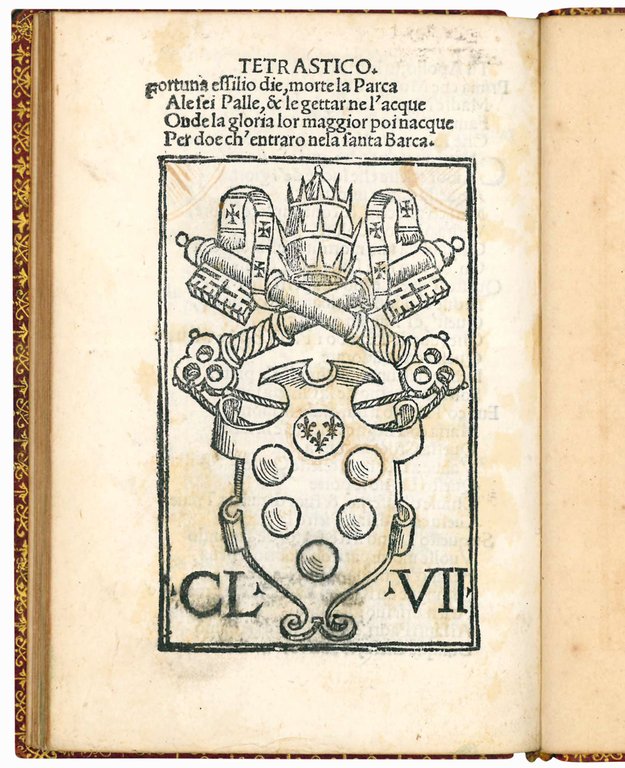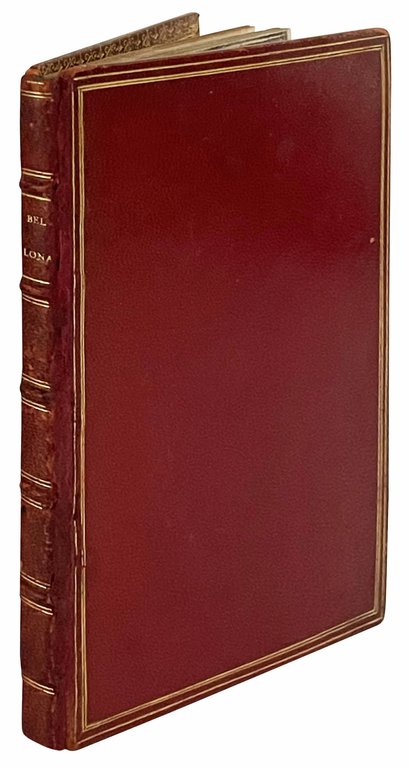



Libri antichi e moderni
CASIO DE'' MEDICI, Girolamo (Girolamo Pandolfi, 1464-1533)
Libro intitulato Bellona nel quale si tratta di arme, di letere, e di amore. Composto per il magnifico Casio Felsineo cavaliero & laureato
[Cinzio Achillini], 1525 [between August and November]
3800,00 €
Govi Libreria Antiquaria
(Modena, Italia)
Le corrette spese di spedizione vengono calcolate una volta inserito l’indirizzo di spedizione durante la creazione dell’ordine. A discrezione del Venditore sono disponibili una o più modalità di consegna: Standard, Express, Economy, Ritiro in negozio.
Condizioni di spedizione della Libreria:
Per prodotti con prezzo superiore a 300€ è possibile richiedere un piano rateale a Maremagnum. È possibile effettuare il pagamento con Carta del Docente, 18App, Pubblica Amministrazione.
I tempi di evasione sono stimati in base ai tempi di spedizione della libreria e di consegna da parte del vettore. In caso di fermo doganale, si potrebbero verificare dei ritardi nella consegna. Gli eventuali oneri doganali sono a carico del destinatario.
Clicca per maggiori informazioniMetodi di Pagamento
- PayPal
- Carta di Credito
- Bonifico Bancario
-
-
Scopri come utilizzare
il tuo bonus Carta del Docente -
Scopri come utilizzare
il tuo bonus 18App
Dettagli
Descrizione
8vo (148x100 mm). [28] leaves. Collation: a-g4. Title page within an elegant woodcut border depicting war trophies and armored soldiers on horseback. Woodcut coat of arms of Clement VII on last leaf verso. Later red morocco gilt, marbled endleaves, gilt edges (spine and joints repaired). On the title page later ownership entry of Alessandro Volpi (fl. 1844-1857), veterinary doctor and bibliophile. A very good copy.
Rare first edition. The date of printing can be presumed from the dedication to Cardinal Ercole Gonzaga (dated 1525) and from the historical facts referred in the text. The present is the issue without the colophon; some identical copies, with the same fingerprint, bear the printing place and the name of the printer at the foot of the final woodcut (“Stãpata in Bologna per Cinthio Achillino”).
The Bellona is a poem in 183 ottave in which are described the festivals for the entry in Bologna of the papal legate, the Cardinal and Bishop Innocenzo Cibo, a nephew of Lorenzo de' Medici. Cibo had been appointed in 1523, but took possession of Bologna only two year later. He arrived on August 4, 1525, about six months after the battle of Pavia, in which the King of France Francis I was defeated and captured. Cibo, who supported the Franch party, provided the defense of Bologna from the possible attack of the emperor's army and replaced the Vice-legate Altobello Averoldi with Goro Gheri, Bishop of Fano. Cibo remained in Bologna until November, then he went back to Rome.
Casio's relation, addressed to Ercole Gonzaga, is extremely detailed and lists, by name and surname, all the people who took part in the festivities. He also describes the eight triumphal arches set up on the occasion along Strada Maggiore; to that placed at the “canton del Casio”, near the poet's house, Casio had hung pieces of paper containing verses dedicated to the legate and had thrown others from the window of his house as Cibo passed during the procession.
Girolamo Pandolfi was born in Bologna into a family originally coming from Castel di Casio in the hills surrounding Bologna. He was initiated to the merchant career by his father. In 1497 during a pilgrimage to the Holy Land he was captured by the Turks and then released thanks to the Venetian diplomacy. In 1501 he was granted by Giuliano de' Medici Duke of Nemours the privilege of adding the surname de' Medici to his family name. He spent most of his life between Bologna and Rome as a diplomat at the service of the Bentivoglio and, above all, Medici families. He was a protégé both of Pope Leo X and Clement VII, who in 1523 granted him the title of knight and laureate poet. This attracted upon him the envy of the other poets, in particular Pietro Aretino, Paolo Giovio, Agnolo Firenzuola and Francesco Berni, who wrote harsh verses against him (cf. A. Reynolds, Renaissance humanism at the court of Clement VII: Francesco Berni's “Dialogue Against Poets” in context, New York-London, 1997, ad indicem).
In 1528 he took part in the reform of the Bologna statutes. As a merchant, he played a key role in the trade of works of art, especially between Florence and the courts of northern Italy. He had himself and his family portrayed on several occasions by important artists, in particular Giovanni Antonio Boltraffio (cf. E. Berselli, Un committente e un pittore alle soglie del Cinquecento: Girolamo Casio e Giovanni Antonio Boltraffio, in “Schede umanistiche”, XI, 1997, 2, pp. 123-143). His poems were gathered in a collection entitled Libro intitolato Cronica (ca. 1527) (cf. F. Cavicchi, Girolamo Casio, in: “Giornale storico della letteratura italiana”, LXVI, 1915, pp. 1-51, 356-405; see also L. Quaquarelli, Pandolfi, Girolamo, in: “Dizionario Biografico degli Italiani”, vol. 80, Rome, 2014).
Edit 16, CNCE9833; BMSTC Italian, p. 153; Sander, no. 1757; USTC, 819240.

